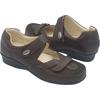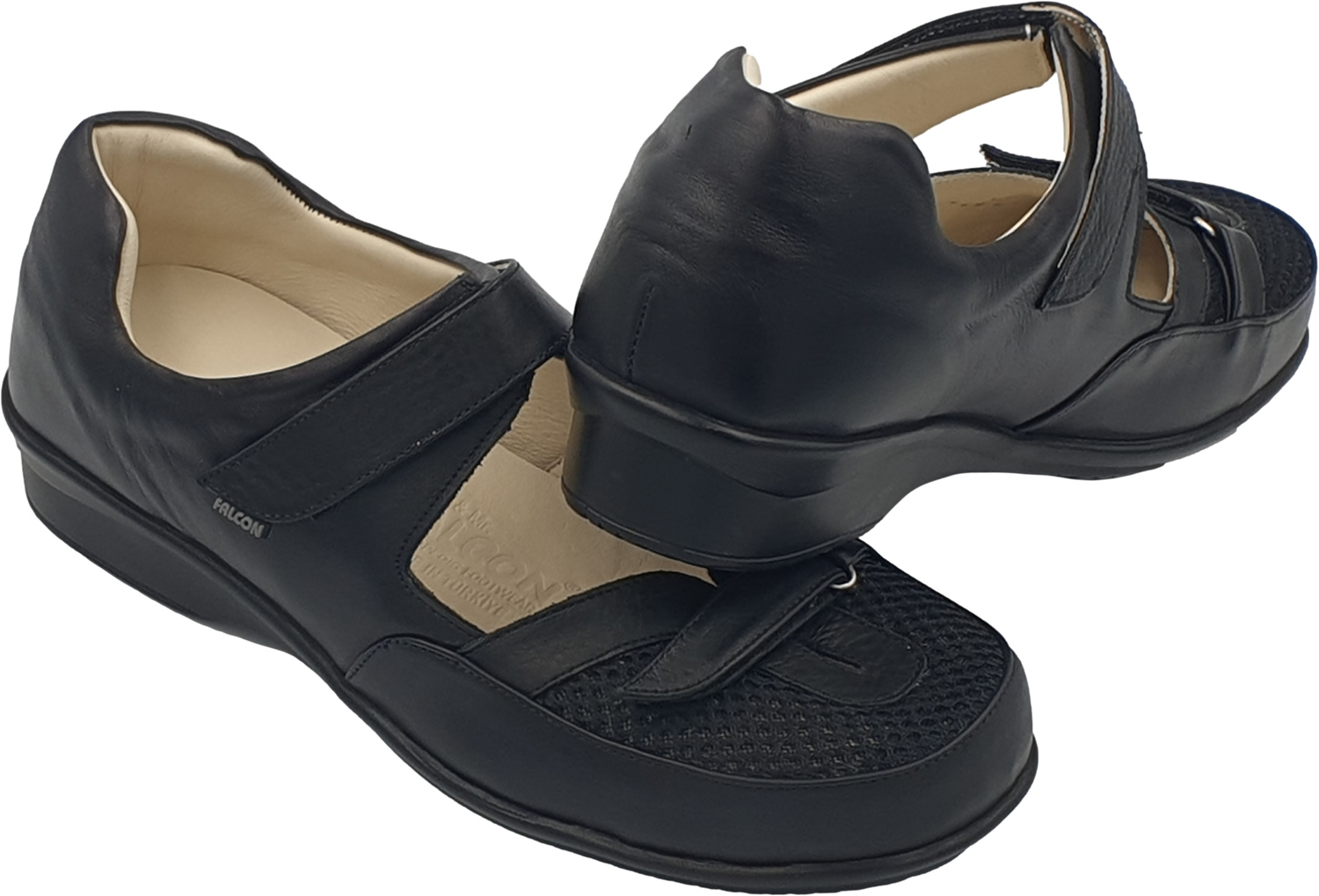Colours
|
Womens shoe sizes
|
TELEFONDA SİPARİŞ VER
+90 212 671 20 21
Tıklayın, telefonunuzu bırakın. Sizi arayalım.
Women's Best Diabetic Medical Shoes Feature
► Best diabetic medical shoes for women
► First quality soft genuine leather
► Best quality orthopedic insole
► Women’s size: 35-36-37-38-39-40-41-42-43
► Summer models.
► Antibacterial and don’t sweat.
► Suitable for women’s foot anatomy.
► Best medical shoes for diabetics foot
► Increase the quality of your life and walk
► PU outsole
► Anti-slip outsole design
► Colours: Black, brown, navy, white and beige
► Model code: ODY-03
► Wide toe area
► No stitches or stitches that are used very little
► Memory sponge
► Made in Türkiye
► Brand: Ladyfalcon
► Full protection for injury
► 2 velcro diabetic shoe models
► The height of the toe part of the polyurethane sole is 1.50 cm and the heel height is 3.00 cm.
The shoes is suitable for pregnant women.
Benefits of Diabetic Medical Shoes for Women ;
► Diabetic shoes provide full protection for injury.
► Minimizes the negative effects of diabetes on the feet.
► Provides protection for infection and ulcers.
► Comfortable finger zone.
How To Measure Your Foot? ( Diabetic medical shoes )
* Look at women's diabetic medical shoes field in the table below.

What is the importance of using diabetic shoes for diabetic patients?
The use of diabetic shoes is crucial for diabetic patients, especially those with diabetes-related foot complications. Diabetes can lead to a condition called diabetic neuropathy, which affects the nerves in the feet. It can also cause poor blood circulation to the extremities. As a result, diabetic patients may experience reduced sensation in their feet and a higher risk of foot injuries and complications. Here's why diabetic shoes are essential for diabetic patients:
» Protection against foot injuries: Diabetic shoes are designed with features that reduce the risk of foot injuries. They typically have a wider and deeper toe box to prevent friction and pressure on the toes, which can lead to blisters, ulcers, and corns. The shoes are also made from soft, breathable materials to reduce the likelihood of rubbing and causing skin irritations.
» Pressure distribution: Diabetic shoes are constructed with special insoles or cushioning materials that distribute pressure evenly across the foot. This is particularly important for individuals with diabetic neuropathy who may not feel pain or pressure normally. Even pressure distribution can prevent the development of calluses and ulcers, which can be severe in diabetic patients.
» Improved circulation: Diabetic shoes have features that promote better blood circulation to the feet. Good blood flow is essential for wound healing and reducing the risk of infections, especially in individuals with poor circulation due to diabetes.
» Offloading pressure points: Diabetic patients with foot ulcers or sores need shoes that offload pressure from affected areas. Specialized diabetic shoes can redistribute pressure away from these vulnerable spots, allowing wounds to heal more effectively.
» Customization: In some cases, diabetic shoes can be custom-made to accommodate specific foot deformities or ulcers, ensuring a better fit and enhanced protection.
» Prevention of complications: Foot complications, such as ulcers and infections, are common in people with diabetes and can lead to serious consequences, including amputations. Wearing diabetic shoes can significantly reduce the risk of such complications, contributing to better overall foot health.
» Reduced risk of falls: Properly fitting diabetic shoes with good traction can reduce the risk of slips and falls, which can be particularly dangerous for individuals with diabetes who may have reduced sensation and balance issues.
What is Diabetes?
Diabetes is a chronic medical condition characterized by high blood sugar levels over an extended period. It occurs when the body either doesn't produce enough insulin (a hormone that regulates blood sugar) or cannot effectively use the insulin it produces. There are three main types of diabetes:
► Type 1 diabetes: An autoimmune disease where the immune system attacks and destroys the insulin-producing cells in the pancreas. People with type 1 diabetes require daily insulin injections or an insulin pump to survive.
► Type 2 diabetes: This is the most common form of diabetes, where the body becomes resistant to insulin or doesn't produce enough insulin. It is often linked to lifestyle factors such as obesity, physical inactivity, and genetic predisposition. Type 2 diabetes can be managed through lifestyle changes, oral medications, and sometimes insulin therapy.
► Gestational diabetes: A temporary form of diabetes that affects pregnant women, usually during the second or third trimester. It occurs when hormones produced during pregnancy interfere with insulin function. Gestational diabetes can increase the risk of complications during pregnancy and childbirth and may also predispose the mother and child to type 2 diabetes later in life.
Diabetes requires ongoing management to prevent complications such as heart disease, kidney damage, nerve damage, and vision problems. Proper management includes maintaining a balanced diet, regular exercise, monitoring blood sugar levels, taking prescribed medications (if needed), and working closely with healthcare professionals.
What are the diabetes treatment options?
Treatment options for diabetes depend on the type and severity of the condition. The primary goals of diabetes management are to control blood sugar levels, prevent complications, and improve quality of life. Here are some common treatment options:
► Lifestyle modifications: For prediabetes and type 2 diabetes, lifestyle changes play a crucial role in managing the condition. These include adopting a balanced diet, engaging in regular physical activity, losing weight if overweight or obese, and quitting smoking if applicable.
► Oral medications: People with type 2 diabetes may be prescribed various oral medications that help improve insulin sensitivity, reduce glucose production in the liver, or stimulate insulin release.
► Insulin therapy: People with type 1 diabetes and some with type 2 diabetes may require insulin injections to regulate blood sugar levels. Insulin can be administered using syringes, insulin pens, or insulin pumps.
► Glucose monitoring: Regular blood glucose monitoring is essential for people with diabetes to keep track of their sugar levels and adjust their treatment plan accordingly.
► Continuous Glucose Monitoring (CGM): CGM devices can provide real-time information about blood sugar levels, helping patients and healthcare providers make more informed treatment decisions.
► Bariatric surgery: In some cases of severe obesity-related type 2 diabetes, bariatric surgery may be considered as an option to improve blood sugar control and promote weight loss.
It's important to note that diabetes management should be personalized to each individual's needs, and regular follow-up with healthcare professionals is essential to adjust treatment plans as needed. Additionally, diabetes self-management education and support programs can help individuals learn how to manage their condition effectively.
Who Is At Risk For Diabetes?
Several factors can increase the risk of developing diabetes. The main risk factors include:
► Family History: Having a family history of diabetes, especially if a close family member like a parent or sibling has the condition, increases the risk.
► Obesity and Inactivity: Being overweight or obese and leading a sedentary lifestyle are significant risk factors for type 2 diabetes. Excess body fat can lead to insulin resistance, making it harder for the body to regulate blood sugar.
► Unhealthy Diet: Consuming a diet high in processed and sugary foods, as well as excessive intake of sugary beverages, can contribute to the development of type 2 diabetes.
► Age: The risk of type 2 diabetes increases with age, especially after the age of 45. However, due to the rising obesity rates among younger populations, diabetes is becoming more common at a younger age.
► Prediabetes: Having higher than normal blood sugar levels, a condition known as prediabetes, increases the risk of developing type 2 diabetes.
► Physical Inactivity: Leading a sedentary lifestyle with little or no physical activity increases the risk of type 2 diabetes.
► Ethnic Background: Some ethnic groups, such as African Americans, Hispanics, Native Americans, and Asians, have a higher risk of developing diabetes.
► Gestational Diabetes: Women who had gestational diabetes during pregnancy are at higher risk of developing type 2 diabetes later in life.
It is essential for individuals with risk factors to be aware of their increased susceptibility to diabetes and to adopt a healthy lifestyle. Regular exercise, a balanced diet, and routine medical check-ups can help manage and reduce the risk of developing diabetes or prediabetes. If there is a family history or other significant risk factors, it is important to consult a healthcare professional for proper evaluation and preventive measures.
Check out the products / categories below that we think might be of interest to you
Can I shop safely on your site?
All purchases you make through https://www.medicalfootwear.net use the latest technologies and the best service provider for your safety.
Once you enter your credit card number under SSL security, you can be sure that no one will have access to this information. No one can view or access your information except you. The information about your number is encrypted and sent to your bank if you enter your credit card number. Your information can not be accessed by third parties, including https://www.medicalfootwear.net in this sense. Your card information is only known and protected by you and your bank.
Product price : 199.00 USD
When are orders shipped?
Products are generally shipped within 1-5 business days.
When will my order be delivered?
Products shipped are usually delivered to your address within 3-7 business days.
We ship with Fedex, DHL, UPS adn TNT, which are the leading cargo companies of express courier transportation. If you have a different request, please contact our company.
Where can I track my order?
You can track your order in the “my orders” section on our website. In addition, you can track the shipment directly by clicking on the link that is sent to your email address.
I cannot access the tracking information for my order. What am I supposed to do?
You need to contact us directly or through our support department if you encounter such a problem.
Which regions do you ship to?
You can shop online from anywhere in the world.
Safe Shopping
Free Shipping
Shipping Within 1-5 Days
Best Quality Products
These Products May Be Interested
Summer Diabetic Footwear for Women ODY04
199.00 USDOrthopedic Diabetic Shoes for Women OD04
199.00 USDComfort Diabetic Shoes for Women OD02
199.00 USDDiabetic Shoes For Women Model OD01
199.00 USD
Best Selling Products
Comfort Diabetic Shoes for Women OD02
199.00 USDOrthopedic Diabetic Shoes for Women OD04
199.00 USDSummer Diabetic Footwear for Women ODY04
199.00 USDDiabetic Shoes For Women Model OD01
199.00 USD























